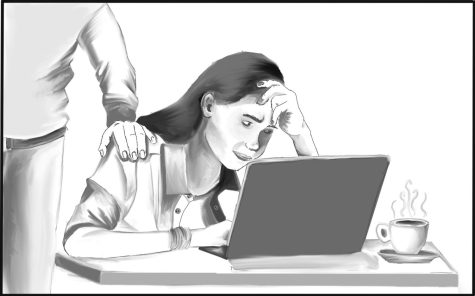From Markets to Marathons
A BHS Teacher Demonstrates the Value of Perseverance

There’s one last marathon on Ogilvy’s bucket list: the New York Marathon. Photo courtesy of Pam Ogilvy.
AP Economics teacher Pam Ogilvy ran the Indianapolis Marathon on Nov. 4.
This is not the first time Ogilvy has completed a 26.2 mile race; it’s her sixth time across the finish line.
“I started running in 2011, and I’ve run six marathons and even more half-marathons,” Ogilvy said. “I ran smaller races at first, but then my friends and everybody kept saying to try it, and I just wanted to see if I could do it. And I did. Barely.”
After her first marathon, Ogilvy’s primary motivation was to improve and push herself. Her best time so far was Columbus in 2016, where she finished in 3:46.25.
“I was just so addicted to pushing myself that year,” she said. “And I really watched what I was eating. A marathon can burn 4,500 calories, so you have to really watch what you put in your body before, but after the race, you just eat everything you see.”
With the exception of one year which she took off, Ogilvy invests an incredible amount of time each year into rigorous training. The training can be a time for her to unwind.
“It’s just as much about a mental thing as a physical thing. I don’t listen to music or anything like that,” she said. “I try not to see it just as an athletic endeavor either.”
“My training is one hour to one and a half hours every day that I get to just train by myself, five days a week,” she added. “On weekends, it’ll be like two and a half hours.”
In fact, Ogilvy runs so much that her toes have been damaged.
“Yes, it’s gross,” she said. “Training puts your feet through a tough beating. I’ve had countless blisters and bruises on my feet and toes, so losing a toenail is just something that happens.”
According to Ogilvy, a runner will unconsciously tense up and clench down on their shoes, which creates a pressure that forms a blister under the toenail.
“When that blister subsides, the toenail is all misshapen and weird looking, and eventually it just falls off, like a baby tooth,” she said. “But–plot twist–there’s already a little baby toenail underneath. Circle of life.”
Ogilvy admits she enjoys scaring people with her toenails from time to time.
The training program Ogilvy follows is called the Hanson Method, where the premise is to exhaust the body for months before the race. Then when it comes to the day of the marathon, the body is conditioned. It will not be tired, and it will work.
“You train your body to continue to operate while you’re tired,” Ogilvy said. “It teaches your body to recover quickly, and you don’t break down during the race.”
According to the Hanson Method website, a program for a beginner marathon spans 18 weeks and consists of working up towards the final mile goal, with the daily training ranging anywhere from a day of rest to 2-mile jog to a 16-mile race. The schedule for an advanced marathon spans the same amount of time, only with more intense workouts every day.
However, Ogilvy did not follow Hanson Method exactly in preparing for Indianapolis. Her training spanned 24 weeks instead of 18.
“Even on the days when you don’t want to train, you have to,” she said. “You have to set aside an hour and a half every day just devoted to this. It’s a lot of hours, and I overtrained this time. To give you an idea, I started training around the AP exams last spring.”
Ogilvy says it helps her immensely to have friends cheering her on. This year, science teacher Alex Paulchell, middle school teacher Michele Toomey and social studies teacher Missy Buddenhagen were waiting for her at the finish line in Indianapolis.
“I was tired and sore that day,” Ogilvy said. “But my friends were waiting at the finish line and Mr. Paulchell was there with a cute sign he made for me. When I came around the bend and saw Mrs. B, Mrs. Toomey and Mr. Paulchell, I just started crying. And when they hugged me, I was still crying. It is really meaningful to see the people who helped you along the way.”
Paulchell brought a neon orange sign, which read “Don’t Poop Your Pants, Pam!”
“Some runners have incontinence issues,” Buddenhagen explained. “Sometimes when you run too far, you poop. You can’t control it.”
Ogilvy insists she does not have such issues.
The purpose of running for her is to test her limits.
“Honestly, there’s something to be said for setting a goal and working your butt off to get there,” Ogilvy said. “I can test the limits of my body that way.”
“It’s like you can say, ‘I can really do something.’” Buddenhagen said. “It’s like you can achieve something impossible. I mean, 26.2 miles: that’s far.”

“It’s also a great thing to say you’ve done,” Ogilvy said. “When I’m 80 years old and I can’t walk, I’ll look at my feet and say, ‘Remember when we did that?’”
Now that the marathon has ended, Ogilvy spends her newfound free time reading for pleasure and sleeping. She will resume training next year.
“I feel like a bum now that I’m not training and all focused on work,” she said. “Running is addicting, runner’s high and all that.”
There is one last marathon that is on Ogilvy’s bucket list: the New York Marathon.
“It’s really hard to get into,” Ogilvy said. “New York is a lottery, but they give precedence to the people who live in the tri-state area, so it’s hard to get in as an outsider.”
Regardless, Ogilvy would like to go one day if presented the opportunity.
“I always find peace in running and feel good after I finish,” she said. “And really, that’s what’s important.”

Jinle Zhu has been writing for The Beachcomber since her freshman year (2014). She has been the features editor and layout editor. She likes Photoshop...












